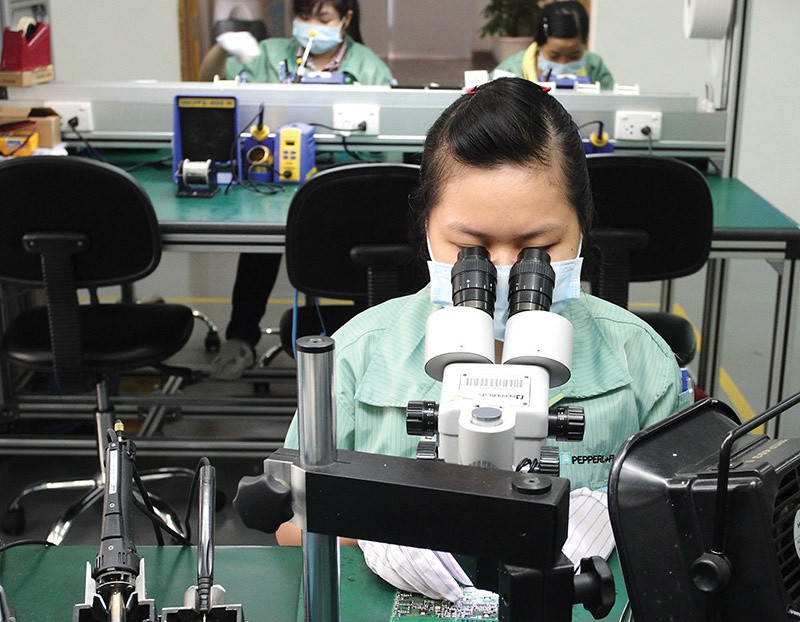 |
| Well-known groups are continuing to pour money into Vietnam specifically for research and development, Photo: Le Toan |
LEGO Group COO Carsten Rasmussen last week arrived in Vietnam to speed up the preparation of a $1 billion complex in the southern province of Binh Duong.
At last week’s meeting with the Danish toymaker, Deputy Prime Minister Pham Binh Minh said, “This is the largest capital from a Danish group investing in Vietnam, confirming the faith and optimism of Lego, as well as the interest of other Danish investors in this country.”
Fresh updates recently revealed by the Ministry of Planning and Investment that the total newly-registered foreign direct investment (FDI) into Vietnam last year amounted to $38.85 billion, up 25.2 per cent on-year, thanks to two billion-dollar projects registered at $7.7 billion and both licensed on the last day of 2021.
An annual report on FDI in Vietnam released last week by the Vietnam Association of Foreign-Invested Enteprises (VAFIE), which did not include the two aforementioned billion-dollar projects in their figures, said that newly-registered FDI is still making the largest proportion of the total capital inflows at 44 per cent in 2019, 51.34 per cent in 2020, and 48.9 per cent in 2021.
Newly-registered capital is increasing sharply year by year in Vietnam, from $4.3 million per project in 2019, to $5.8 million in 2020, and $8.8 million in 2021. Additionally-registered capital was also soaring in both value and proportion.
However, the report pointed out that the number of high-tech projects entering Vietnam from developed economies is not many, and the number of enterprises setting up a research and development (R&D) centre in the country is much fewer.
“The world economic growth is slowing down, and global FDI may decline. Moreover, competition in investment attraction is increasingly fierce, so it is difficult for Vietnam to achieve the goals of quality and socioeconomic efficiency unless calling for high-quality foreign-invested project funding,” said Professor Nguyen Mai, chairman of VAFIE.
According to Resolution No.50-NQ/TW issued in 2019 on improving the quality and efficiency of FDI by 2030, the registered capital is set to be about $150-200 billion in the 2021-2025 period, and about $200-300 billion during 2026-2030, while disbursed capital is set at $100-150 billion for the 2021-2025 period and $150-200 billion during 2026-2030.
The resolution asked the proportion of enterprises using advanced technology, modern management, and environmental protection to increase by 50 per cent; the proportion of trained workers to rise by 70 per cent; and the localisation ratio to soar by 30 per cent by 2025 and 40 per cent by 2030.
Additionally, FDI will be focused on the green economy and the transfer of green technologies.
Mai said that the quantity target set out in the resolution is achievable on the basis that Vietnam has a stable political and macroeconomic institution, with a large market and a growing middle class. Besides this, the investment and business environment is increasingly improved and international integration is extensive. Moreover, Vietnam has many conditions for investors to reduce production costs and connect with global supply chains.
However, in terms of the quality of foreign-invested projects, as of date, the number of projects with modern technologies from the United States and Europe accounts for 5 per cent, medium technologies capture 80 per cent, and outdated ones make up 15 per cent, Mai explained.
Meanwhile, foreign-invested enterprises building R&D centres work in IT, electronics, and telecommunication only. Specifically, Samsung is developing its $220-million R&D centre in Hanoi, and Qualcomm’s only lab in Southeast Asia is in the capital. Panasonic and Toshiba are also said to be pondering R&D development in Vietnam. Other foreign investors in other sectors, however, have been so far quite indifferent to R&D.
“It may be quite hard to accomplish the target set in terms of the quality of FDI attraction,” urged the professor.
In order to improve this, Tran Thi Hong Minh, director general of the Central Institute for Economic Management, has proposed some solutions including synchronising policies and legal frameworks on investment and business, as well as maintaining improvement of the general business climate.
Bui Huy Hung, assistant of the state president, highlighted the renewal of awareness and unified action. “Furthermore, relevant agencies need to strengthen inspection and supervision, as well as provide policies to support businesses and investors to remove difficulties. Legal provisions and implementation of intellectual property should be enhanced to protect the rights of investors, as well as promote investment in high technologies and innovation.”
Source: VIR